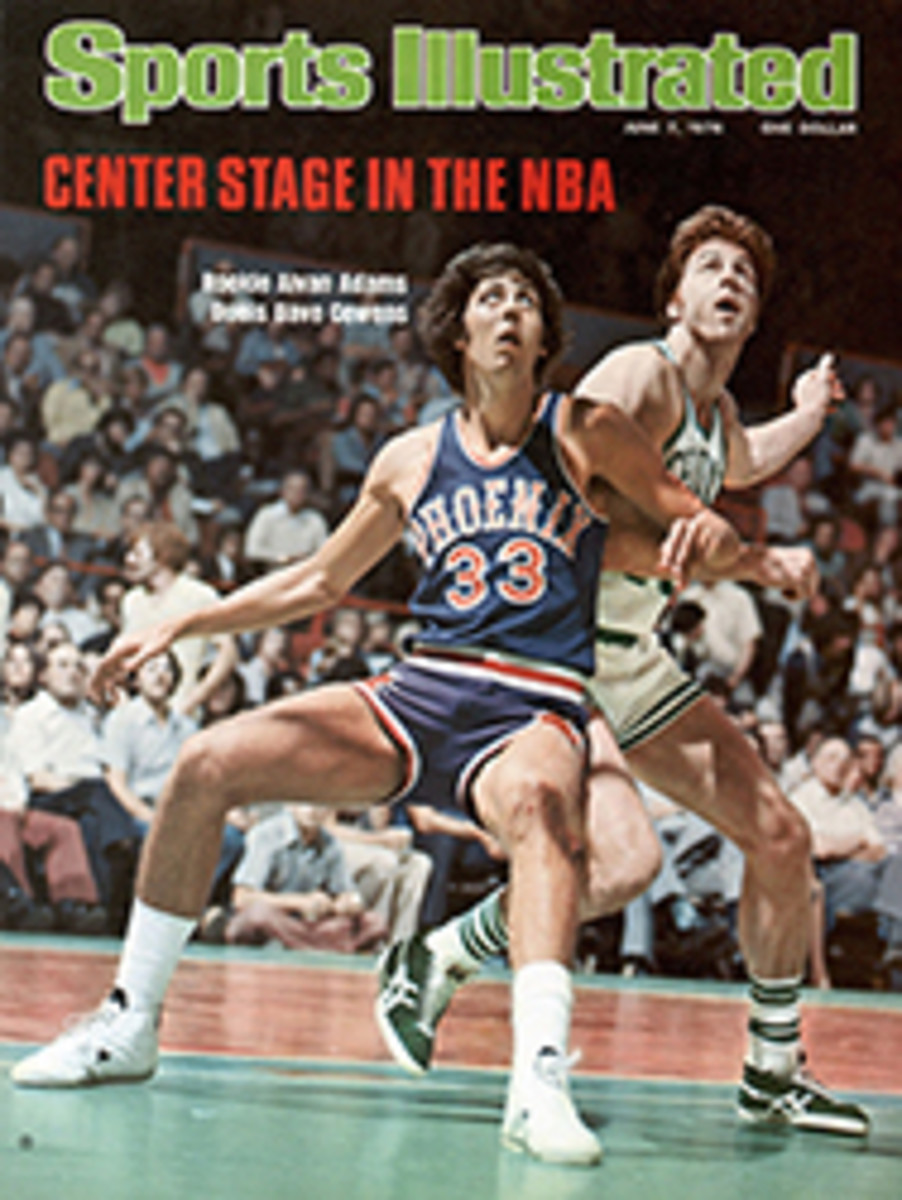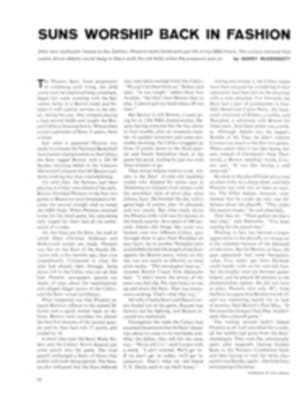
Big Red sticks it to the Terps
On the eve of Saturday's NCAA lacrosse championship at Brown University, Cliff Stevenson, the host school's lacrosse coach, sat in the stands in Brown Stadium watching the undefeated finalists, Maryland and Cornell, work out. Less than two weeks before, Stevenson's squad had played them back to back. "This could be the greatest lacrosse game of all time," he said. "I've been coaching 26 years and these are the two best teams I've ever seen."
Stevenson was right on the button. For dramatics this year's championship was unsurpassed. Before a noisy crowd of 11,954 the game boiled to a 12-12 tie and went into overtime, with Cornell playing under protest. The disputed play had allowed Maryland to draw even with only one second remaining in regulation time, but ultimately the protest was academic. Outhustling and outchecking the Terps, Cornell pulled away to a 16-13 win, adding a second NCAA crown to the one it had captured in the tournament's first year.
The tournament was started in 1971 to help promote the game, and over the years it has produced enough upsets, controversies, records and, yes, money to make it a success. This year, for the first time, the tournament drew national TV exposure. ABC's Wide World of Sports was there in Providence, proof positive for aficionados, who can be a little tiresome on the subject of the growth of lacrosse. In truth, the sport's stature was better summed up by a short conversation that took place between two ABC technicians immediately after they had been briefed on some fundamentals of the game—four quarters, goals count one point, play starts with something called a faceoff, which takes place at midfield.
"Is this the first time lacrosse has been on national television?" asked one.
"Yep," answered the second. "We could make or break the sport." If lacrosse fails to survive ABC's treatment of it, it can at least claim to have exited on a glorious note. This was the first time in tournament history that the championship game matched undefeated teams. More important, the finalists had reached their appointment with destiny, or at least with the American Broadcasting Company, by trampling all over their tournament opponents. Maryland had scored in the first 14 seconds of its opener with Brown and built up a 9-0 lead on the way to an easy 17-8 win. But almost before the Terrapins could finish flexing their muscles, word arrived from Cornell that the Big Red had demolished its opening-round foe, Washington and Lee, 14-0. In lacrosse, shutouts occur about as often as visitations from ABC.
Maryland went right back to work proving that it deserved to be the No. 1 seed by rolling up an 11-1 lead over fourth-ranked Navy and then coasting to a 22-11 win. The 22 goals were a tournament record. Then news came from Cornell that the Big Red had built up its own 11-1 lead, over third-ranked Johns Hopkins, before winning 13-5.
Nor had the regular season offered much of a challenge for either team. Cornell's average margin of victory was 11 goals, Maryland's was nine. True, the Terps had been taken into overtime by Atlantic Coast Conference opponents North Carolina and Virginia, but in those overtime periods Maryland had outshot them 26-0. Against Virginia, the Terrapins poured in nine goals in less than five minutes.
Maryland was so explosive offensively this year that 37 times it scored within 25 seconds after a faceoff. Cornell players referred to the Terrapins' extra-man offense as the "Guns of Navarone." The Terps' coach, Bud Beardmore, was a high-scoring midfielder at Maryland and he had built his offense there around a midfield starring a cast of thousands. In lacrosse, midfielders play for short periods of time and frequently change on the fly the way lines do in ice hockey. Depth is crucial, and Maryland was so well manned that Roger Tuck, a Terrapin All-America midfielder, was serious when he said, "A really big part of our game plan is simply to run the opposing midfield into the ground."
So deep was Maryland, in fact, that although it was the highest scoring team in the nation, none of its players finished in the top 12 in goals, assists or points. In all, 25 different Terps scored this season, 16 of them midfielders.
Despite incessant talk about the quality of Maryland's depth, no one lumped Frank Urso with the rest of the midfield. Last Saturday was Urso's final game, and he is likely to be remembered as the best collegiate player ever. In his career at Maryland he led the Terps to the NCAA finals in all four years and made first-team All-America every season. His overtime goal won the 1973 NCAA title for Maryland, and his record-tying five goals in last year's championship game gave the Terps their second NCAA title. As a sophomore he was named Midfielder of the Year. As a junior he was named Player of the Year. As a senior he was so good no one could think of a description worthy of the man.
Urso has been the most heavily honored athlete at Maryland, but the stature of lacrosse being what it is he finds that his has not exactly become a famous name, even in College Park. When the university gave him a silver bowl last year to commemorate his selection as an All-America, "lacrosse" was spelled on the inscription without an "e."
Urso had hoped to make a living wielding a stick by playing professionally in the indoor version of the game, box lacrosse, but that dream died on Friday, the 13th of February, when the National Lacrosse League folded. When Urso was asked recently whether, if he had to do it all over again, he would reconsider football, a sport in which he was heavily recruited, he answered, "Definitely."
Like Beardmore, Cornell Coach Richie Moran played midfield at Maryland, but whereas Beardmore set a school scoring record for midfielders (since broken by Urso), Moran was more defense oriented. "I was like a caddie," he says. "If the ball was on the ground, it was my job to get it."
Accordingly, Moran's Cornell mid-field, which came closer to matching Maryland's depth than that of any other team, emphasized defense. "Richie won't play a midfielder unless he's sound defensively," said Billy Marino, Cornell's best middie.
The Cornell offense was also solid. This year the Big Red may well have had the best attack unit ever to play the game. Senior Mike French is now lacrosse's all-time leading scorer. In his career he totaled 191 goals and 296 points and topped the nation in those categories for three consecutive years. Junior Eamon McEneaney complemented French perfectly. A superb feeder, McEneaney led the country in assists during the past two years, and the third member of the group, a scholarly, bespectacled dentist-to-be named Jon Levine, popped up every time an opponent cut off the other two. In the semifinals against Hopkins, Levine scored five goals.
Both coaches insisted that for the championship game they would stick to what they had been doing all season. But Moran had a few wrinkles devised to neutralize Maryland's offensive midfield power. "Their middies haven't had to play much defense," he said. "We're going to control the ball and make them do it. Every five minutes Urso and the others are on the field they're going to have to play two or three minutes of defense. That should cut down their effectiveness offensively. And every time they shoot we're going to be fastbreaking one or two of our guys. That should keep their middies backing up and maybe take them out of their shooting range."
Cornell's deliberate play held the Terps in check until early in the second quarter. With the Big Red leading 2-1 on the strength of two French goals, the Terrapins exploded. Within five minutes, six different Terps scored to open a 7-2 lead. At the end of that blitz the public-address system asked spectators to get off the field, causing one observer to remark, "Those aren't spectators. That's the Cornell lacrosse team."
The half ended 7-2. The score might have been even more one-sided but the Terps' extra-man offense, those "Guns of Navarone," failed to score in six man-up situations. Cornell was able to contain Maryland's offense in the third period and slowly began to chip away at the score. The Terrapins simply couldn't control French, who added three more goals and three more assists as the Big Red rolled to tie at 10-10. Then, with a tricky pass behind his head that brought the crowd to its feet, French hit Levine for a quick goal and Cornell had the lead. French scored unassisted less than a minute later to give the Big Red a 12-10 edge with less than seven minutes to play.
Now it was Urso's turn. He scored Maryland's first extra-man goal with three minutes remaining to cut the lead to one. With just 15 seconds left, Urso got the ball again and began one of his typical dashes down the middle. A flag flew, Urso shot. Cornell Goalie Dan Mackesey knocked the ball away from the goal and play stopped with six seconds remaining. Five minutes of confusion followed, and when the officials gave the ball to Urso again to start play near midfield, Moran blew up and put the game under protest. Once again Urso charged, only this time when the Cornell defense collapsed around him, he passed crisply to Greg Rumpf, who scored to send the game into overtime.
In lacrosse, overtime consists of two mandatory four-minute periods followed by sudden death if necessary. It wasn't. The deciding goal came with nine seconds left in the first overtime. Marino brought the ball into play from the side, dodged past Maryland Midfielder Jim Burnett and fired the ball home.
After Levine scored for a 15-13 lead, Urso tried one last dash. He was met at midfield by Cornell's attackmen, Levine, French and McEneaney, who simultaneously belted him to the ground, where he stayed. McEneaney flipped the ball to French, who put in his seventh goal of the game to tie a tournament record.
An on-the-field awards ceremony followed the game. Moran had spent the week trying to keep himself under control, or "down on the farm," as he says, but now his Irish got the better of him. Seizing the microphone, he raised a single finger in the air and shouted, "Cornell, baby, we're No. 1."
PHOTO
MARYLAND COULDN'T CONTAIN CORNELL ATTACKMAN FRENCH. RESULT: A TOURNAMENT RECORD TYING SEVEN GOALS

